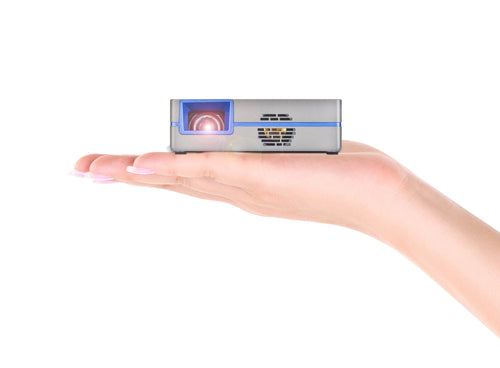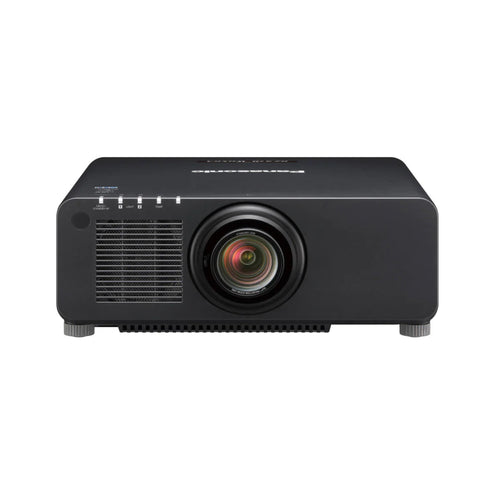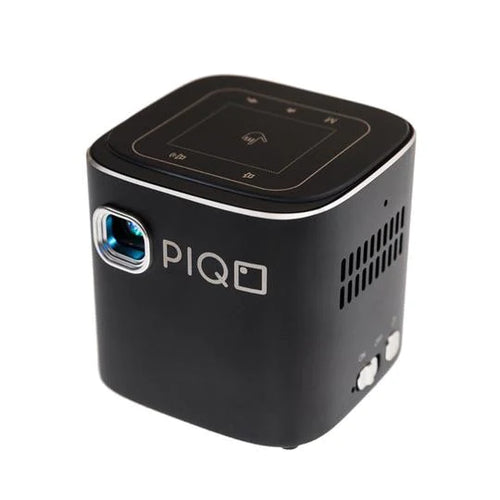From Dust to Smudges: Step-by-Step Instructions for Cleaning Projector Lenses

Projectors have become a staple in many aspects of our lives, from business presentations to home theater setups and educational settings. They deliver crisp, clear images, making their lenses a critical component.
Over time, projector lenses can accumulate dust and dirt that impact the quality of the projected images. A clean lens is the gateway to vibrant and sharp projections, while a dirty or smudged lens can distort and degrade the image quality.
Whether you have a large or a small projector like PIQO’s, its lens is bound to collect dust, fingerprints, and smudges after some time. So, it is essential to regularly clean your projector lenses to ensure their optimal performance.
In this comprehensive guide, we will tell you how to clean projector lens, ensuring your device continues to deliver outstanding performance.
The Necessity of Clean Projector Lenses
Dirty projector lenses can significantly impact the quality of your projected images. The following are key points to consider:
- Image Quality. Clean lenses are critical for maintaining high image quality. Dust and smudges on the lens surface can create artifacts and distortions visible in the projected images.
- Dust particles on the lens can scatter the light from the projector lamp, leading to distorted and blurred projections. These distortions are particularly noticeable as dark spots or streaks on the screen.
- Loss of Brightness. Dust can absorb and scatter light, reducing the brightness of the projected image even if you have a 1080p projector. A clean lens allows the projector to deliver its intended brightness, ensuring your content is displayed as it should be.
- Smudges and fingerprints on the lens can lead to a loss of clarity. Over time, these contaminants can accumulate and become more challenging to clean, affecting the viewing experience.
- Regular cleaning not only ensures better image quality but also extends the projector's life. By reducing the risk of dust settling on internal components, you help maintain the projector's performance.
Whether you use a projector for home entertainment, business presentations, or educational purposes, the quality of your projections relies on having clean lenses.
Gather Your Cleaning Supplies
Before you embark on cleaning your projector lens, it's essential to gather the right cleaning supplies. Using the appropriate materials ensures that you clean the lens effectively without causing any damage.
Here are the essential supplies you'll need to clean your big or small projector:
- Microfiber Cloths. Microfiber cloths are designed to be gentle on lens surfaces while effectively picking up dust and smudges. They are the preferred choice for cleaning projector lenses.
- Lens Cleaning Solution. A dedicated lens cleaning solution is ideal for safely removing smudges and fingerprints from the lens. Look for a solution specifically designed for use with optics.
- Air Blower. An air blower, often a rubber bulb, removes loose dust particles from the lens surface. It's a crucial first step in the cleaning process.
- Lens Cleaning Tissues or Swabs. Lens-cleaning tissues or swabs can be helpful for stubborn smudges or hard-to-reach areas. Ensure that these are designed for lens cleaning to avoid any scratching.
- Lens Cleaning Pen. A lens cleaning pen combines a brush to remove loose dust and a microfiber pad to clean the lens. It's a versatile tool to have on hand.
- Lens Cleaning Wipes. Pre-moistened lens cleaning wipes are convenient for quick clean-ups. However, for thorough cleaning, it's recommended to use a microfiber cloth and lens cleaning solution.
These supplies will prepare you for the “how to clean projector lens” part.
Preparing Your Workspace
A clean and controlled workspace is essential for the cleaning process. Follow these steps to prepare your workspace:
- Stable Surface. Place your projector on a stable and level surface. This ensures the projector won't accidentally move or tip over during cleaning.
- Proper Lighting. The right lighting in your workspace is crucial for spotting dirt and smudges on the lens. Use even, natural light or a bright, diffused artificial light source.
- Turn Off and Unplug the Projector. Safety is paramount when cleaning a projector lens. Before you start, turn off the projector and unplug it from the power source. This eliminates the risk of electrical shock or accidental activation of the projector.
Following these steps creates a safe and efficient environment for cleaning your projector lens.
How to Clean Projector Lens: Step-by-Step Instructions
Now that you've prepared your workspace and gathered your cleaning supplies, it's time to clean your projector lens. Follow these step-by-step instructions to learn how to clean projector lens:
1. Initial Inspection
Start by conducting an initial inspection of the lens. Look for visible dust, smudges, or contaminants. Identifying the type of dirt will help you determine the best approach for cleaning.
2. Remove Loose Dust
The first step in cleaning your small projector’s lens is to remove loose dust particles. Hold the projector vertically and use the air blower to blow air onto the lens surface. This dislodges loose dust without the risk of scratching the lens.
3. Wipe the Lens with a Microfiber Cloth
For smudges, fingerprints, and more stubborn contaminants, it's time to use the lens cleaning solution. Apply a small amount of it to a clean, soft, lint-free microfiber cloth.
Avoid applying the solution directly to the lens, as this can lead to excess liquid seeping into the lens.
Using the microfiber cloth with the lens cleaning solution, gently wipe the lens in a circular motion. Start from the center of the lens and work your way outward. Applying gentle pressure is sufficient to remove most smudges and contaminants.
4. Address Stubborn Smudges
For particularly stubborn smudges or stains, you can use lens-cleaning tissues or swabs. Moisten the swab or tissue with the lens cleaning solution and gently address the smudge. Avoid excessive pressure to prevent any scratching on the small projector.
5. Air Dry
After cleaning, allow the lens to air dry for a few moments. Avoid using compressed air, as it may contain particles that could land on the lens. Recheck the lens to ensure it is clean and free of smudges.
6. Regular Cleaning
It's advisable to clean your projector lens regularly to prevent the accumulation of dirt and smudges. How often you clean your lens may depend on your environment, but a monthly cleaning is a good starting point.
By following these step-by-step instructions, you can learn how to clean projector lenses and ensure their outstanding image quality.
Preventative Maintenance
Preventing dust and smudges from accumulating on your projector lens can save you time and effort in the long run. Consider these preventative maintenance tips:
- Lens Caps or Covers. Many projectors come with lens caps or covers. When the projector is not in use, always keep the lens covered. This prevents dust and contaminants from settling on the lens.
- Dust-Free Environment. Where you place your projector can significantly impact the frequency of cleaning. Avoid placing the projector in dusty or smoky environments, as this increases the likelihood of contaminants reaching the lens.
- Cleaning Projector Filters. In addition to cleaning the lens, it's essential to address projector filters. Projector filters prevent dust from entering the projector and affecting internal components. Check your projector's manual to locate and access the filter.
If your projector has a cleanable filter, gently remove and clean it according to the manufacturer's instructions. In cases where the filter is not cleanable or has reached the end of its lifespan, it's essential to replace it.
Check the user manual or contact the manufacturer for information on compatible replacement filters. Properly maintaining the filter ensures that your projector remains dust-free, reducing the need for frequent lens cleaning.
Troubleshooting Common Lens Issues
While regular cleaning and maintenance can prevent most lens issues, occasionally, you may encounter additional problems. Here are some common lens-related issues and how to troubleshoot them:
- Scratches on the lens surface can significantly impact image quality. If you notice scratches on your projector lens, contact the manufacturer or a professional technician. Attempting to remove scratches yourself may worsen the problem.
- Condensation can occur when the projector moves from a cold to a warm environment. If condensation forms on the lens, do not attempt to wipe it. Allow the projector to acclimate to the new environment, and the condensation will dissipate.
- Internal Dust. If you notice dust inside the projector, it's advisable to contact the manufacturer or a professional technician. Internal dust requires specialized cleaning and cannot be addressed through the lens.
Remember, a clean lens not only enhances the visual experience but also extends the life of your projector. Take care of your lens; your projector will cover your visual needs for years.
So, don’t shy away from buying a projector just because of its regular cleaning needs. Get your hands on PIQO Mini Projector this Black Friday with a whopping 50% discount. This means you can turn your home into a cinema for only $399 instead of $799 by using the “EARLYSALE” code.
Conclusion
A clean projector lens is the key to vibrant, sharp, and high-quality projections. Regular cleaning and preventative maintenance are essential for ensuring your projector continues to deliver outstanding performance.
You can maintain their optimal image quality by knowing how to clean projector lenses. Additionally, don't forget to address the cleanliness of projector filters, which play a critical role in keeping internal components dust-free.
With proper care and maintenance, your projector will consistently provide excellent projections, whether you're using it for home entertainment, business presentations, or educational purposes.








